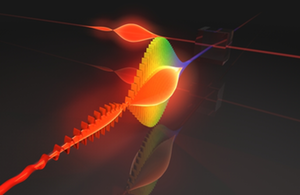Measuring the Shape of a Photon
Encoding information in individual photons is one approach to perfectly secret communications and powerful computing, but reliably retrieving the information can be tricky. In Physical Review Letters, researchers demonstrate a way to fine-tune the measurement of a series of individual photons that are in an identical but arbitrary state. The scheme also expands the possibilities for using complex internal states of light to transmit data.
A pulse of light can have almost any shape in space and in time, determined by the amplitudes and phases of its frequency components. Surprisingly, single photons can also be generated in a variety of complex shapes. The difference is that the amplitude for a single photon doesn’t represent a definite value of the electric field strength; instead it’s associated with the probability of detecting the photon at each location and time.
Researchers could also encode information in the photon shape and transmit it from one place to another. There is so much flexibility that a single photon could represent any letter in the alphabet, for example, or even a quantum combination (superposition) of several letters. But the detection system must be able to distinguish, say, the letter P from the letter Q, even after the photon has been distorted during the trip from the transmitter.
Marco Bellini of the National Institute of Optics in Florence, Italy, and his colleagues, have now demonstrated a technique to calibrate such a system by measuring the precise shape that appears at the receiving end under fixed conditions. They adapted methods from the field of coherent control, where researchers precisely sculpt the time-dependent electric field of a laser pulse.
The idea is to “mix” the photon to be measured with an intense laser pulse, allowing the photon and the pulse to interfere and either reinforce or cancel one another, depending on their shapes. The closer the shapes, the more likely it is that the photon will be detected. The team optimized the match by repeating the mixing many times with identical photons and periodically reshaping the pulse based on data from the previous batch of such measurements.
To implement their strategy, the researchers first created two streams of ultrashort laser pulses by splitting a single laser beam. One stream was sent into a crystal that occasionally generated a pair of photons—one to be detected after intentional or unintentional morphing, the other to be used as a trigger for the detector. The other stream, called the local oscillator, contained more powerful pulses that the team could shape and then mix with photons.
In their demonstration, the researchers manipulated only the frequency components of the local oscillator pulses, although they say the scheme could allow tuning of spatial variations, too. They first used a grating to separate the different frequency components, then independently modified the intensity and phase of each component, and finally used a second grating to reassemble them. “You can obtain whatever shape you want,” Bellini says.
To select the best intensities and phases to match the photon shape, the team used a “genetic” algorithm inspired by biological evolution. Starting with randomly chosen parameter values, they periodically replaced them with values that were “inherited” in scrambled form from the ones that had previously been most successful at detecting the photons. This process was repeated until the best solutions emerged.
The researchers also showed that their scheme could recover information that was intentionally encoded in complex states of a photon. As an example, they created photons that had two separate frequency components with a particular phase difference. These photons were efficiently detected using local oscillator pulses that had a matching phase difference. But when the components in the local oscillator were exactly out of phase from the photons, almost no photons were detected.
The optimized detection scheme is “pure and simple coherent control in the same way that it is done classically,” says Avi Pe’er, of Bar Ilan University in Ramat-Gan, Israel. “The point is that now these are single photons,” he says. Tzu-Chieh Wei of Stony Brook University in New York says the demonstration of complex encoding is particularly striking because the absence of detection in some conditions means that the system is truly sensitive to the coherent internal state of the photons.
–Don Monroe
Don Monroe is a freelance science writer in Murray Hill, New Jersey.





